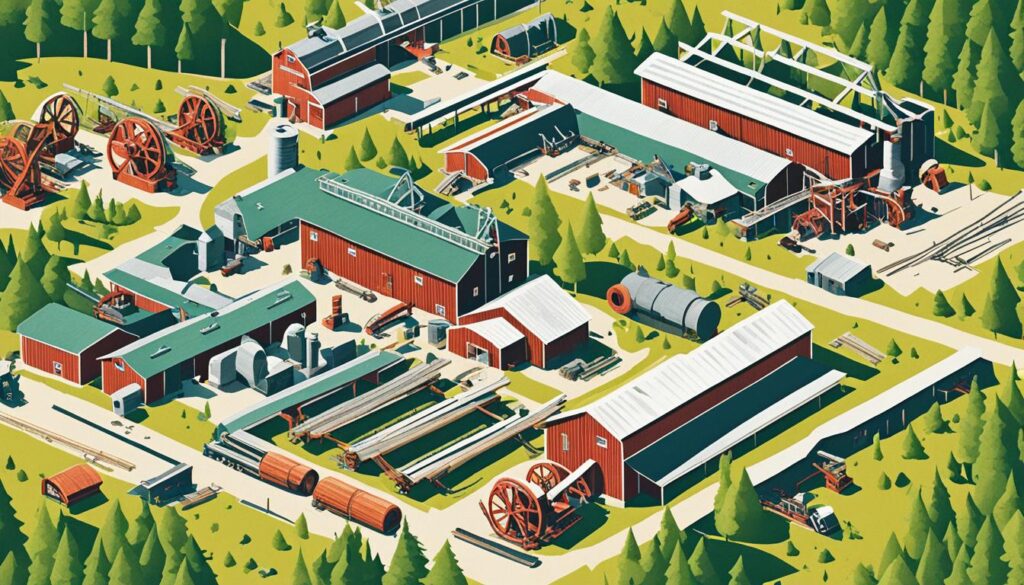Starting a sawmill business is both thrilling and challenging. The costs to start a sawmill depend on your goals and size. Whether you dream of a small setup or a large lumber factory, knowing the initial costs is key.
Deciding on wood processing investments needs careful thought. Many sawmill owners start small and grow over time. For instance, Matt Ruben began with a basic Wood-Mizer LT40 sawmill and some woodworking tools. In three years, he expanded to include custom sawing, drying, and furniture making.
Your entry into the lumber industry might also start small. First, think about your goals, what you have, and what the market needs. Success comes from planning well and growing wisely.
Key Takeaways
- Sawmill startup costs vary based on scale and equipment choices
- Starting small and expanding gradually is a common strategy
- Essential equipment includes a sawmill machine and basic woodworking tools
- Consider land requirements for log storage and operations
- Explore opportunities for diversification, such as custom sawing and furniture making
- Carefully assess local market demands before investing
Understanding the Sawmill Business Landscape
Starting a sawmill business needs careful planning and understanding the industry well. The cost of your timber milling will depend on the operation type and the market you’re in. Let’s look at the main parts of the sawmill business world.
Types of Sawmill Operations
Sawmills have different types, each needing different amounts of money to start:
- Portable milling services
- Stationary mills with retail/wholesale wood sales
- Custom sawing for specific projects
Your choice affects how much money you’ll need for your business. For example, Matt Ruben began his sawmill with basic and grew over time. This shows you can start small and expand.
Market Demand and Potential Customers
Knowing your market is key to setting your budget. Your customers could be:
- Homeowners looking for custom lumber
- Woodworkers needing special cuts
- Construction companies needing large amounts of materials

Legal Requirements and Regulations
Before getting funding, look into the legal side:
- Land use permits
- Environmental laws
- Business licenses
These things affect how much money you’ll need. Remember, starting costs can change a lot based on your business and where you are.
Essential Equipment and Infrastructure Costs
Starting a sawmill business needs careful planning and investment in key equipment and infrastructure. It’s important to know the costs of sawmill equipment and woodworking facilities. This knowledge helps with budgeting and success.
Choosing the Right Sawmill Machine
The sawmill machine is the core of your business. Models like the Wood-Mizer LT40 are a good choice for their performance and price. Prices vary from $20,000 to $50,000, based on features and capacity. Think about your production goals when picking a machine to make sure it fits your needs.

Additional Tools and Machinery
You need more than just the main saw to run a sawmill efficiently. Key tools include:
- Skid steer for log handling
- Planer for smooth finishes
- Slab flattening machine
- Drying kiln for proper wood curing
These tools will increase your costs, but they’re vital for a complete operation.
Setting Up Your Work Area
Your work area is key for efficiency and safety. You might use existing buildings or build new ones. Think about space for:
- Sawmill shed
- Workshop for processing
- Storage buildings for inventory
A vacuum kiln is costly but boosts drying and business growth. Plan your layout well to reduce material handling and increase productivity.
How Much Does It Cost to Start a Sawmill Business
Starting a sawmill business needs careful planning and money. The costs to start can change a lot based on your operation’s size and the equipment you pick.
For a small-scale portable sawmill, you might spend about $10,000 to start. This basic setup lets you start with low overhead. As your business grows, you can buy more equipment to do more.
A bigger sawmill operation needs more money. Starting a logging business can cost between $10,000 and $500,000, depending on the scale and what you need. Here’s a list of possible costs:
- Sawmill machine: $5,000 – $50,000
- Additional tools and machinery: $5,000 – $20,000
- Land and buildings: $10,000 – $100,000
- Raw materials: $5,000 – $20,000
Remember, ongoing costs like maintenance, labor, and utilities will increase your total costs. Focusing on high-margin production rather than high volume can help you make more money in the sawmill business.
When thinking about the costs to start a sawmill business, remember. Investing in good equipment and planning well can lead to success and profits over time.
Operating Expenses and Ongoing Costs
Starting a sawmill business means looking closely at costs. You need to think about lumber manufacturing expenses and wood processing investment. These costs are key to knowing if your business will make money.
Raw Material Procurement
Getting logs is a must for your sawmill. You can buy them or cut them down yourself. The price depends on the wood type and quality you want.
Labor and Staffing Considerations
How much you spend on labor depends on your sawmill’s size. If it’s small, you might do most of the work yourself. But if it’s big, you’ll need skilled workers, which costs more.
Maintenance and Repairs
Keeping your equipment in good shape is important. Replacing and sharpening blades are big costs. You’ll need about three blades for every thousand board feet you cut.
Other costs include fuel for your machines and moving them around. For mills that stay in one place, electricity for kilns is another expense. When setting your prices, think about all these costs. Some sawmills charge by the hour or per board foot. Make sure your prices cover everything.
For more tips on starting a service business, check out this guide on starting a roadside service business.
Financing Options and Return on Investment
Starting a sawmill business needs careful planning, especially with funding. You’ll want to look at different ways to get money. Personal savings can help, but bank loans and equipment financing are also good options for bigger costs. Make sure your budget includes all the equipment and costs you’ll need.
The ROI in the sawmill industry can change a lot. It depends on how well you run things, the demand for your products, and how you price them. Small sawmills might struggle against bigger, more efficient ones. To increase your ROI, think about offering premium services for more money or setting a minimum charge for jobs.
To make more money in your sawmill business, aim for bigger jobs, make your operations more efficient, and grow your customer base. Adding custom drying or making finished wood products can also increase value. A good plan for funding and a solid budget are crucial for doing well in this industry.
FAQ
What types of sawmill operations are there?
Who are the potential customers for a sawmill business?
What legal requirements and regulations should I consider?
What essential equipment is needed for a sawmill business?
What are the costs involved in setting up a sawmill work area?
What are some typical startup costs for a sawmill business?
What are some ongoing costs to consider?
What financing options are available for starting a sawmill business?
Author
-

Lucas Martinez is an accomplished entrepreneur with a passion for startups. He has launched and scaled multiple businesses, providing pragmatic advice on starting and growing a business.
View all posts



